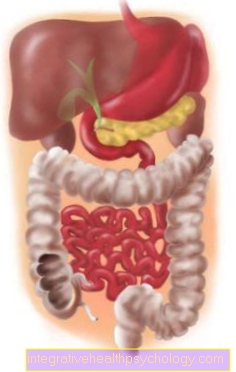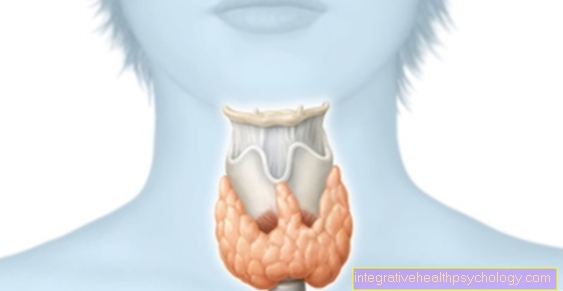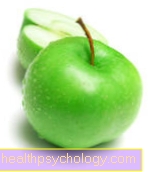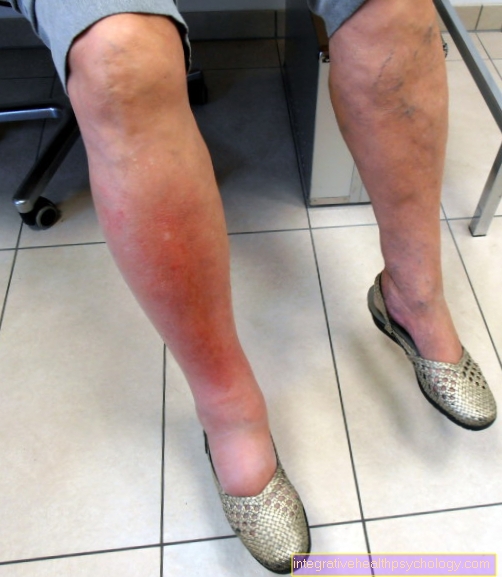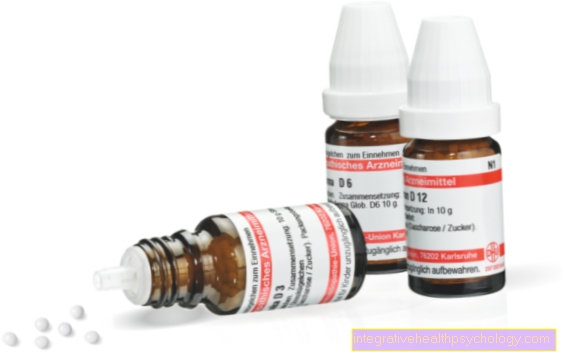Medication to promote labor
introduction
If the due date has already passed or if there are reasons to induce labor, there are various means of stimulating labor.
The drug of choice here is the pregnancy hormone oxytocin. After consultation with the gynecologist or midwife, however, food that promotes labor can also achieve the desired effect if it is not yet necessary to induce labor with medication.

These drugs promote labor
The main medication used to promote labor is the hormone oxytocin.
Oxytocin is also released from the body during the birth process and then has a positive effect on labor. In addition, the hormone stimulates the milk ejection from the mammary gland after birth and strengthens the mother's relationship with the child.
If the birth has to be initiated externally, oxytocin is given via a permanent perfusor. The device ensures that a predetermined amount of the hormone can be continuously given through the vein. This then has an intensifying effect on the rhythmic contractions of the uterus.
Another drug that promotes labor is prostaglandin. It must be given through the vagina so that it can work. One advantage of prostaglandin is that it has few side effects on the rest of the body, but the drug is difficult to control, which is why oxytocin is the drug of choice.
The drugs are given when the blood flow to the placenta (placenta) is no longer sufficient to adequately care for the child. This can happen if the calculated date has already been exceeded or if there are illnesses such as pregnancy high blood pressure or gestational diabetes. In addition, medication is used to induce labor if the bladder ruptures prematurely and natural contractions do not start within 12 to 24 hours.
More information can be found here:
- Promote labor
- Contraction drip
homeopathy
In homeopathy we know some preparations that can potentially promote labor.
Before using the globules, you should definitely talk to a gynecologist about the benefits and risks. In addition, a gynecologist with experience in homeopathy can advise you which preparation can show the best effect in the individual situation. Possible preparations are, for example, Pulsatilla or caulophyllum.
What is the so-called labor cocktail?
The labor cocktail can contain different ingredients depending on the recommendation of the midwife or the gynecologist.
Contain most of the so-called labor cocktails Apricot juice, castor oil, almond butter and something alcohol. The alcohol is important so that the castor oil can dissolve in the juice. Castor oil has a laxative effect. So that the electrolyte loss through the castor oil is not too high, special apricot juice is used, which contains potassium. Before mixing such a labor cocktail, you should first consult your gynecologist or midwife. The contact person can then advise on the exact mixing ratio, which is not unimportant.
You might also be interested in this topic: The different types of labor
Foods that promote labor
There are certain foods that are known to be able to induce labor. So it should be avoided if possible during pregnancy. With the food, the dose is very important, which is why small doses usually have no effect on labor.
In the case of fruit, it is known that unripe papaya can cause the uterus to contract. The latex that contains the unripe papaya is responsible for this.
Furthermore, a number of spices have an effect on labor. These include, for example Cinnamon, ginger, coriander, curry, marjoram or cloves. If possible, these should only be consumed in small doses to avoid causing premature labor.
Sugar substitutes, such as those commonly found in Light products or chewing gum used should be avoided.
Read also: Induce labor
Raspberry leaf tea
The raspberry leaf tea is, as the name suggests, an herbal tea made from dried raspberry leaves.
If the tea is drunk in sufficient quantities, it is said to promote labor and widen the cervix. This effect has not been scientifically proven, but there are many experience reports. It is also recommended not to drink the tea in large quantities before the 34th week of pregnancy in order not to cause premature labor.
Like all home remedies that are used to promote labor, tea does not work equally for all women. It is also possible that the pregnant woman does not notice the effects of the raspberry leaf tea at all. Nevertheless, before drinking the tea as a labor-promoting measure, you should first speak to your gynecologist or midwife to make sure that inducing labor is harmless for the child.
You may also be interested in this topic: Labor pain
Labor tea
The Wehentee is a mixture of cinnamon, cloves and ginger and sometimes raspberry leaves or verbena (a verbena plant).
The individual recipes vary again depending on which source you ask. The raspberry leaves are put together with the cloves and the fresh ginger in a tea infuser and poured with sparkling water. The cinnamon can be added directly to the water. Experience reports say that if several cups of this tea are consumed throughout the day, labor can be triggered within one to two days.
For more information read: Use tea to stimulate labor.
cinnamon
Cinnamon has a positive effect on the blood circulation in the pelvic organs and it is also said that it can cause labor.
Since cinnamon is used in many foods, when buying pastries, for example, you should pay attention to whether and how much cinnamon is contained. This is relevant before the due date in order not to trigger premature labor by consuming cinnamon. If the appointment has already been reached or exceeded, an attempt can be made to induce labor with cinnamon biscuits or cinnamon tea after consultation with the gynecologist or midwife.
Do you have anymore questions? Further information on this topic can be found here: Induce labor - when, with what and what are the risks?
castor oil
Castor oil is a powerful laxative and is known as a home remedy for inducing labor.
The castor oil activates the intestines and the uterus, which is then supposed to trigger labor. However, one should be very careful with the intake of castor oil and have discussed the intake with a midwife or gynecologist. Known side effects are nausea, vomiting and intestinal colic.
There are also cases that report that castoroleic acid has passed into the child's circulation. This leads to excessive stress in the unborn child, which can have a negative effect on the birth and the course of the first days of life. In addition, there are no qualitative studies that report on the harmlessness of castor oil. For this reason, the German Medicines Commission expressed a concern about induction of labor with castor oil.
red wine
Depending on the degree of ripeness, red wine contains different levels of histamine. Histamine is suspected of causing labor. Therefore, there is much discussion as to whether a glass of red wine can be used as a means of promoting labor.
However, the histamine content in a glass of red wine is usually not high enough to affect the uterus. Drinking more than one glass is also not recommended. One must not forget that red wine also contains a not harmless amount of alcohol. The alcohol could cause problems if sudden medication has to be given. Therefore, the recommendation is rather not to use red wine to promote labor.
Find out more about:
- Alcohol during pregnancy
- Fetal alcohol syndrome
sparkling wine
Like red wine, sparkling wine contains histamine. The histamine is said to have a stimulating effect on labor.
However, it is questionable whether a glass of sparkling wine contains enough histamine for the desired effect. In addition, the harmful effects of alcohol must be weighed. Therefore it is rather not recommended to use sparkling wine as a means of promoting labor.
You might also be interested in this topic: Alcohol while breastfeeding
Home remedies that promote labor
In addition to food that promotes labor, there are also a number of home remedies and measures that are said to be able to promote labor.
For example, going for a walk or climbing stairs will push the baby's head further into the pelvis. This can help start the labor. However, overexertion of the body should be avoided as this tends to have negative effects on labor.
Another measure that may stimulate contraction is massaging the nipples. The stimulus on the nipple releases the hormone oxytocin, which is largely involved in labor. However, such a massage should not be carried out over a long period of time so that the sensitive skin on the nipples is not irritated.
A quick soak in warm water that is not too hot can help the uterus begin labor by loosening the pelvic muscles. The temperature of the bathing water should be around 38 degrees Celsius. In addition, you should not bathe alone or unsupervised, as the warm water can affect the circulation.
Other relaxation techniques, such as a reflexology massage or an abdominal massage, can also trigger labor.
Read more on the topic: Home remedies that promote labor
Recommendations from our editorial team
- Exercise contractions
- Labor pains
- Proper breathing at birth
- Rupture of the bladder - does the birth begin now?
- initiate birth


